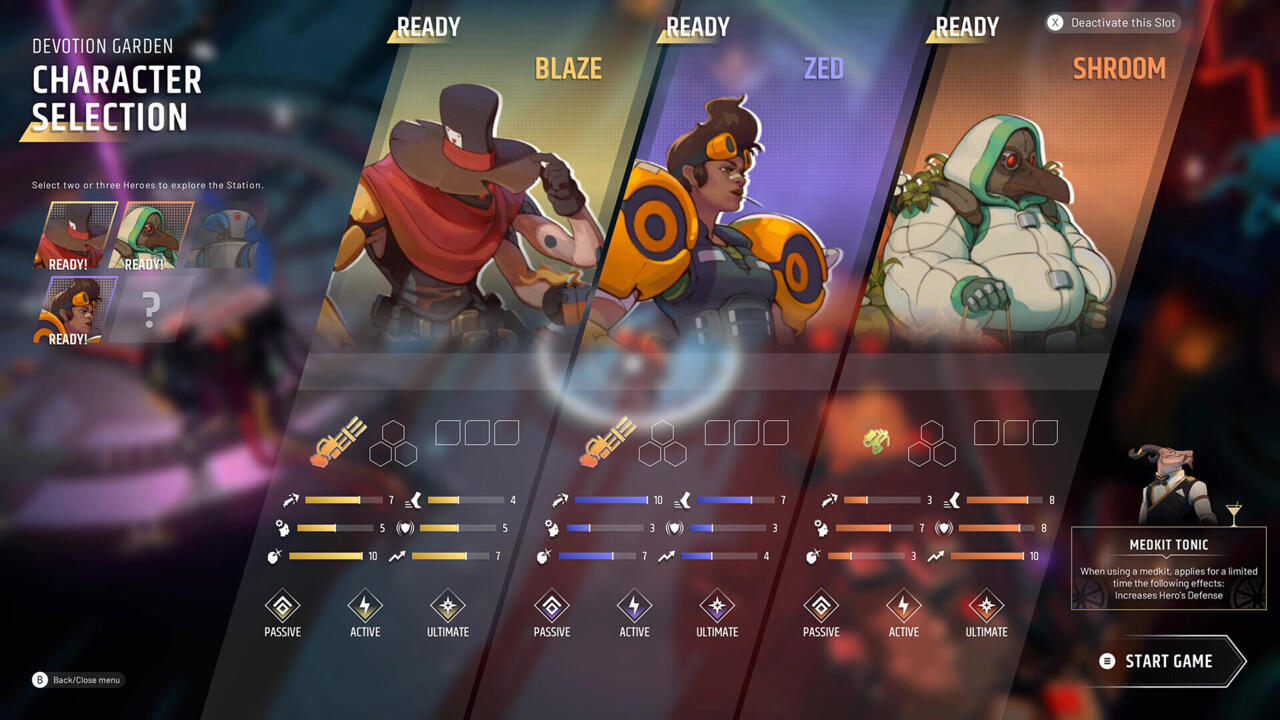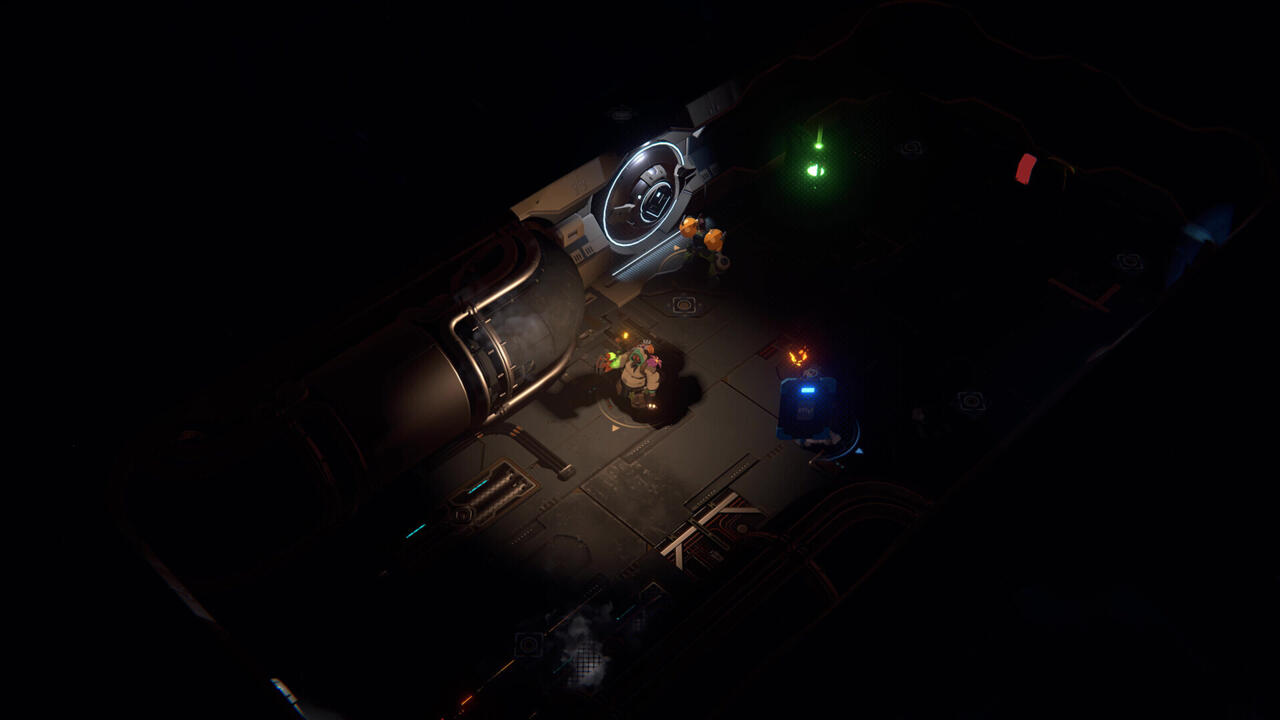Roguelite Endless Dungeon Spices Up Its Tower Defense Levels With A Character-Driven Story
Endless Dungeon builds on over a decade of lore built within the Endless franchise.
In Endless Dungeon, developer Amplitude Studios returns to its primarily 4X strategy franchise. This time, however, the studio is opting for a twin-stick tower defense game with both hero shooter and roguelite elements. It makes for what looks to be an amusing sci-fi romp through a long-abandoned space station, especially if you have a few friends on hand to play with in three-player co-op.
The game sees you play as one of many survivors trapped on a seemingly inescapable space station. The only way out is in the furthest depths of the station. To get there, you’ll need to fight through waves of enemies, erecting defenses in the hallways you clear so that you can more easily escort a fragile crystal from checkpoint to checkpoint. Pushing the crystal forward summons a brand-new wave of enemies to defeat, and if they destroy the crystal (or you), it’s back to the station’s hub area (a saloon) for you.
During a preview event for the game, I spoke to narrative director Jeff Spock and lead game designer Arthur Prudent about Endless Dungeon’s story and how the game centers its narrative elements and hero characters within its roguelite structure. Endless Dungeon is scheduled to launch for Xbox Series X|S, Xbox One, PS5, PS4, Switch, and PC on May 18.
What was most exciting about using the world of Dungeon of the Endless as a narrative backdrop for this new game? What has it been like exploring a different corner of a familiar universe?
Spock: This is what gets me out of bed in the morning. I mean, I love this. I get paid to do this; it’s unbelievable. No, I think doing it as a 4X strategy game, exploring universes as a 4X strategy game is interesting, and just the scope in the exploration, and these giant intergalactic battles and that sort of thing. What you don’t get in those games is individual characters, intimate human stories, moments of dialogue between people and that sort of thing. So what I really love is taking this universe that we’ve been building for 10 or 12 years now through our games, and saying, “Okay, we’re just going to take this one little piece of time, this one little piece of space, and we’re going to do whole series of stories just in there and about that.” And that’s really, really fun because then what I’ve discovered is that all these documents and Wikipedia stuff about the universe that I’ve been writing for 10 years becomes useful. That’s really gratifying.
So we can go back and say, “Okay, well, let’s say it was something Endless did around then this and that.” It’s like, “Oh, there’s this whole story from Endless Space 2, and we can reference that here,” and then show, “Oh yeah, we can do that.” And then, “Okay, but which factions can we have, and should we look at the timeline? Which factions existed? They weren’t dead, they were still there, they weren’t going to be born in the future. So who can we have in the game?” So we’ve been working on the universe long enough. It’s really fun to do this kind of exploration of our own sort of archive, and figure out what kind of stories we can tell where and how, and that kind of thing.

On the flip side, did y’all face any unexpected narrative challenges with this game given that it’s already tied to the world of another game?
Spock: I mean, there are definitely constraints, and there kind of have to be constraints. I don’t want to name names, but there are fictional universes where it started as a thing that was pretty clearly defined, and then it kept getting more ideas and it sort of went off in every direction. And then it sort of loses its consistency and its character and its coherence. And so I’ve been trying as the loremaster of the studio to really even have those limits on what I can do, and we can do, the stories we can tell.
I think it’s important to keep the integrity of these building blocks we put down even 10, 12 years ago. So yeah, that’s just something we accept. There’s things like, “Okay, I really don’t want to have time travel in our universe.” But because once you can do that, then everything sort of falls apart and you can make anything happen anytime–there’s things like that. I really want to have control over what is magic. That’s our Dust, but we have to define pretty clearly what it can and can’t do, and how you use it, things like that. So yeah, constraints, it’s part of the fun, it’s part of the challenge for me.
How is Endless Dungeon’s story told? How do players discover or unlock more of each individual character’s story?
Spock: Yeah, well, that’s a challenge we’d had since the first. We did Endless Space, and the narrative was pretty light in there. There’s an awful lot of backstory in the universe, but it didn’t really come out in the game. Endless Legend was the first time we actually tried to tell a traditional Aristotelian story structure in a 4X game, and that was a huge challenge, and we did it again in Space 2, got a little better at it. So we’re a little bit used to trying to tell standard traditional stories in a procedurally generated game. So expertise is a strong word to use, but we have the scars for trying it. And so part of it is trying to figure out how you structure that.
[In Endless Dungeon], we have Hero Quest–each hero has a four chapter quest–and when you get to the end of it, you get a hero skin and an upgrade. So it’s sort of a little success you can get even if you haven’t made it to the end of the whole, to the core, to the end of the big narrative arc. There’s lots of little narrative arcs like that, and also with those that are trying to encourage you to explore different parts of the dungeon. “Go look for this over there, go see the landmark that’s in this district. Kill this boss,” that kind of thing.
So we’re using the story to tell the story of each character–they’re trying to achieve something, avenge something, explore or understand something, but also explore the station and get that sort of road-like aspect also in the story. So yeah, there’s a few balls in air there, but it’s fun to do, and it’s a very interesting challenge, and Arthur and the design team are really critical in understanding how it gets delivered and when it gets delivered, the pacing and that sort of thing. So it’s very collaborative.
Prudent: You also have a lot of other mechanics communicate the story and we still have a complete journal log. I don’t know if we got an album that you can check.
Spock: There’s a lot of backstory in there and you go through districts. [In] each new district, you pick up some notes, they get filed away, you go back and read them. You pick up some more what we call mementos, which will you give you some of these little video clips of what life looked like on this station, what happened, why it’s the way it is now. There’s a lot of little things like that we put in there. It’s part of the narrative and also part of the meta trying to encourage you to keep going, looking, learning.

How does the game incentivize the player to keep going and try one more time after a failed run? Are there smaller goals for the player to chase beyond the overarching goal of escaping the station?
Prudent: Yeah, definitely. I think it’s one of the most important things that we wanted to add to this game. We really wanted to add something more rewarding and lots of short and medium-term goals.
You also have all these meta provision monies. We have two currencies. And basically the idea behind more currencies is to always give you something to do when you are returning to the saloon. And that’s really the spirit of that. So, for example, in the workshop, you will be able to customize the weapons, the heroes, the crystal, even the saloon by spending some of this currency. So even after a terrible run you still have something to do.
And also we really try to give you a lot of tools to choose to customize the next run. So that’s really important for us to be sure that the next run will not be the same as the previous one. So you have all these heroes, obviously, you have all these optional things that you can put on your characters. For example, they can swap elements that you buy for every one of your characters and decide to customize them a bit differently.
Spock: Yeah, I think once we started putting in the meta elements, I actually minded a lot less when I died and went back to the saloon, because I was like, “Oh I can open up this stand now, or I can upgrade this thing now, or I can go buy this thing I wanted. I can put this on the wall.” And even though I know it and I should be more cynical about it, I actually found the meta elements in the saloon where I found them really cool to play with and to interact with. So yeah, I think that’s good. That’s a thing we really didn’t have in Dungeon in the Endless and I think we’ve learned a lot by seeing and playing other games and I think we’re really trying to do that well.
Without spoiling the game’s ending, will players be able to reach a definitive narrative conclusion at launch? How much of the story is being saved for post-launch?
Spock: So, from the point of view of the hero, of a given hero, yes, they do have an end to their story. However, the end to that hero’s story is not necessarily the end to the story of the station and the saloon and what’s going on in sort of a meta level. And I think when the players get to the end, they’ll start to realize that. So there is, for the individual character that you’ve been playing through this horrible experience for hours and hours and hours, they have an ending and it’s not a bad one, but there’s sort of more going on. So yeah, there are possible extensions and that kind of thing, it could come afterward.
This interview was edited for brevity and readability.
The products discussed here were independently chosen by our editors. GameSpot may get a share of the revenue if you buy anything featured on our site.
Got a news tip or want to contact us directly? Email news@gamespot.com







Join the conversation